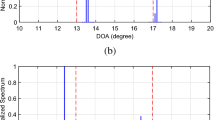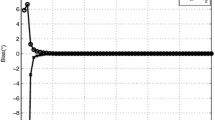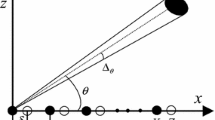Abstract
In this paper, we devise an effective algorithm for direction-of-arrival (DOA) estimation using the cross-dipole array via one-bit quantization. Firstly, we theoretically prove that after one-bit quantization, two circular complex Gaussian random processes with different variance still satisfy the arcsine law and calculate the normalized covariance matrix of the cross-dipole array output based on this property. Subsequently, we reconstruct the noise-free normalized covariance matrix by subtracting the normalized noise matrix. Finally, we apply the TLS-ESPRIT algorithm to the reconstructed noise-free normalized covariance matrix to extract the DOAs of sources. Numerical results demonstrate the validity of the proposed algorithm.





Similar content being viewed by others
Data Availability
My manuscript has no associated data.
References
O. Bar-Shalom, A.J. Weiss, DOA estimation using one-bit quantized measurements. IEEE Trans. Aerosp. Electron. Syst. 38(3), 868–884 (2002)
Z. Cheng, S. Chen, Q. Shen, J. He, Z. Liu, Direction finding of electromagnetic sources on a sparse cross-dipole array using one-bit measurements. IEEE Access 8, 83131–83143 (2020)
M. Fu, Z. Zheng, W.-Q. Wang, H.C. So, Coarray interpolation for DOA estimation using coprime EMVS array. IEEE Signal Process. Lett. 28, 548–552 (2021)
J. He, L. Li, T. Shu, Sparse nested arrays with spatially spread orthogonal dipoles: high accuracy passive direction finding with less mutual coupling. IEEE Trans. Aerosp. Electron. Syst. 57(4), 2337–2345 (2021)
J. He, Z. Zhang, T. Shu, W. Yu, Direction finding of multiple partially polarized signals with a nested cross-diople array. IEEE Antennas Wirel. Propag. Lett. 16, 1679–1682 (2017)
X. Huang, B. Liao, One-bit MUSIC. IEEE Signal Process. Lett. 26(7), 961–965 (2019)
X. Huang, S. Bi, B. Liao, Direction-of-arrival estimation based on quantized matrix recovery. IEEE Commun. Lett. 24(2), 349–353 (2020)
G. Jacovitti, A. Neri, Estimation of the autocorrelation function of complex gaussian stationary processes by amplitude clipped signals. IEEE Trans. Inf. Theory 40(1), 239–245 (1994)
H. Krim, M. Viberg, Two decades of array signal processing research: the parametric approach. IEEE Signal Process. Mag. 13(4), 67–94 (1996)
J. Li, Direction and polarization estimation using arrays with small loops and short dipoles. IEEE Trans. Antennas Propag. 41(3), 379–387 (1993)
J. Li, P. Stoica, Efficient parameter estimation of partially polarized electromagnetic waves. IEEE Trans. Signal Process. 42(11), 3114–3125 (1994)
J. Li, R.T. Compton, Angle and polarization estimation using ESPRIT with a polarization sensitive array. IEEE Trans. Antennas Propag. 39(9), 1376–1383 (1991)
C. Liu, P.P. Vaidyanathan, One-bit sparse array DOA estimation. Proceeding IEEE International Conference on Acoustics, Speech and Signal Processing (ICASSP), New Orleans, LA, USA (2017), p. 3126–3130
X. Meng, J. Zhu, A generalized sparse Bayesian learning algorithm for 1-bit DOA estimation. IEEE Commun. Lett. 22(7), 1414–1417 (2018)
A. Nehorai, E. Paldi, Vector-sensor array processing for electromagnetic source localization. IEEE Trans. Signal Process. 42(2), 376–398 (1994)
M.J. Pelgrom, Analog-to-Digital Conversion (Springer, New York, 2013)
J.H.V. Vleck, D. Middleton, The spectrum of clipped noise. Proc. IEEE 54(1), 2–19 (1966)
Z. Wei, W. Wang, F. Dong, Q. Liu, Gridless one-bit direction-of-arrival estimation via atomic norm denoising. IEEE Commun. Lett. 24(10), 2177–2181 (2020)
K. Yu, Y.D. Zhang, M. Bao, Y. Hu, Z. Wang, DOA estimation from one-bit compressed array data via joint sparse representation. IEEE Signal Process. Lett. 23(9), 1279–1283 (2016)
Z. Zheng, Y. Huang, W.-Q. Wang, H.C. So, Augmented covariance matrix reconstruction for DOA estimation using difference coarray. IEEE Trans. Signal Process. 69, 5345–5358 (2021)
C. Zhou, Y. Gu, Z. Shi, M. Haardt, Structured Nyquist correlation reconstruction for DOA estimation with sparse arrays. IEEE Trans. Signal Process. 71, 1849–1862 (2023)
C. Zhou, Y. Gu, Z. Shi, M. Haardt, Direction-of-arrival estimation for coprime arrays via coarray correlation reconstruction: a one-bit perspective. Proceeding IEEE Sensor Array and Multichannel Signal Processing Workshop (SAM), Hangzhou, China (2020), p. 1–4
Acknowledgements
This work was supported in part by the National Natural Science Foundation of China under Grant 62171089, by the Natural Science Foundation of Sichuan Province under Grant 2022NSFSC0497, by the Sichuan Science and Technology Program under Grant 2021YFG0155, by the Science and Technology Plan Project of Huzhou city under Grant 2023GZ16, and by the Shenzhen Science and Technology Program under Grant JCYJ20210324143004012.
Funding
National Natural Science Foundation of China (62171089), Natural Science Foundation of Sichuan Province (2022NSFSC0497), Sichuan Science and Technology Program (2021YFG0155), Science and Technology Plan Project of Huzhou city (2023GZ16), Shenzhen Science and Technology Program (JCYJ20210324143004012).
Author information
Authors and Affiliations
Corresponding author
Ethics declarations
Conflict of interest
The authors declare that they have no known competing financial interests or personal relationships that could have appeared to influence the work reported in this paper.
Additional information
Publisher's Note
Springer Nature remains neutral with regard to jurisdictional claims in published maps and institutional affiliations.
Appendix A: Proof of (17)
Appendix A: Proof of (17)
Assume that X and Y are two real-value zero-mean Gaussian random variables with variances \(\sigma ^2_X\) and \(\sigma ^2_Y\), respectively. The joint probability density function of X and Y is given by
where \(\rho =E\{XY\}/\sigma _X\sigma _Y\) denotes the cross-correlation coefficient. With one-bit quantization, the amplitudes of X and Y are \(X^{[1b]}=\textrm{sign}(X)\) and \(Y^{[1b]}=\textrm{sign}(Y)\), and then the cross-correlation function is expressed as
where
Introducing ellipse polar coordinates \(X=\sigma _Xr\cos (\phi )\) and \(Y=\sigma _Yr\sin (\phi )\), (29) can be simplified as [17]:
Next, we consider two zero-mean CCGPs \(\tilde{X}(t)\) and \(\tilde{Y}(t)\) with variances \(\sigma ^2_{\tilde{X}}\) and \(\sigma ^2_{\tilde{Y}}\), respectively. Denoting \(\tilde{X}^{[1b]}(t)\) and \(\tilde{Y}^{[1b]}(t)\) as the result of \(\tilde{X}(t)\) and \(\tilde{Y}(t)\) after one-bit quantization, the cross-correlation function of \(\tilde{X}^{[1b]}(t)\) and \(\tilde{Y}^{[1b]}(t)\) is computed as
Each term in the last row of (32) satisfies the arcsine law. Thus, we have
For two CCGPs, the following equations hold:
Substituting (34) and (35) into (33) yields
Evidently, two CCGPs with different variance also satisfy the arcsine law.
Rights and permissions
Springer Nature or its licensor (e.g. a society or other partner) holds exclusive rights to this article under a publishing agreement with the author(s) or other rightsholder(s); author self-archiving of the accepted manuscript version of this article is solely governed by the terms of such publishing agreement and applicable law.
About this article
Cite this article
Guo, N., Teng, Y. & Zheng, Z. One-Bit DOA Estimation Using Cross-Dipole Array. Circuits Syst Signal Process 43, 3324–3336 (2024). https://doi.org/10.1007/s00034-024-02615-3
Received:
Revised:
Accepted:
Published:
Issue Date:
DOI: https://doi.org/10.1007/s00034-024-02615-3




